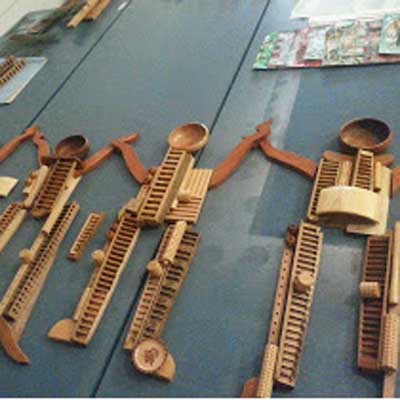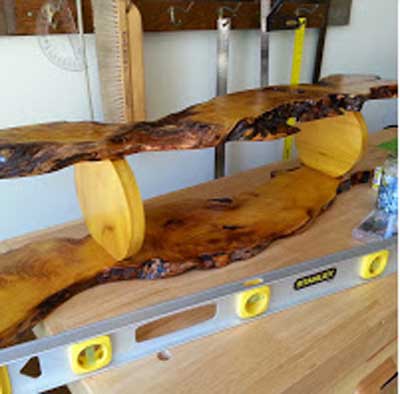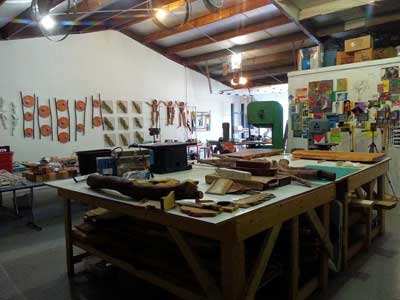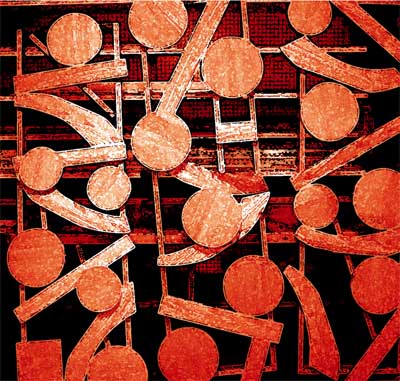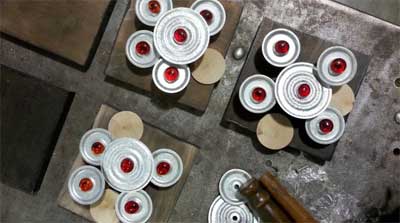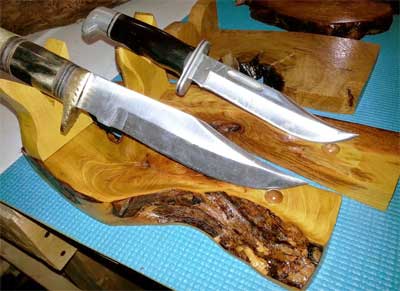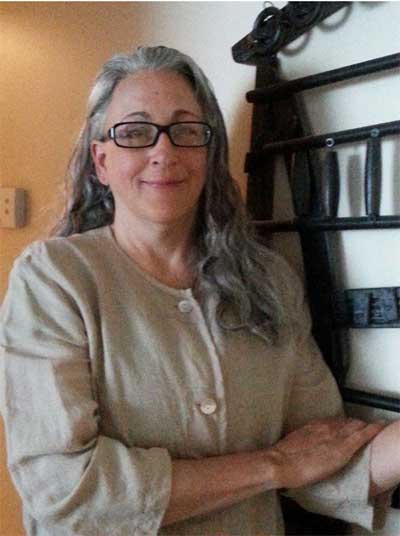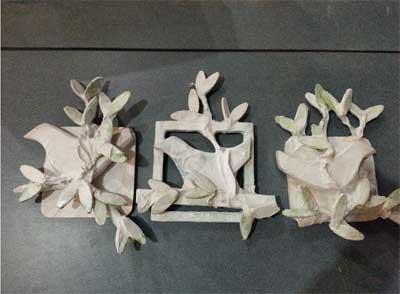
Valerie Hibbard grew up in a family where “it was always respected if you knew how to make things,” but, after graduating from high school (and its two years of home ec classes) in 1979, “I veered off into fiber arts. It was more acceptable for women,” she said.
After 30 years of making quilts, handspun yarn, etc., however, Valerie wanted to move on from doing the same thing, to use her art degree and do “more real art.” She also wanted to do “something lasting, that would be around after I was gone.”
“Quilts — people throw up on them, they use them when they go camping, dogs chew on them. My handwoven rugs would last 20, maybe 25 years if somebody took care of them.”
The sculptures she makes now, from wood and other materials, are more resistant to harm. “The sun won’t hurt them; they won’t get harmed in the washer. About the only thing that would hurt my pieces is fire.”
When she first started working with wood, Valerie was using branches – which presented challenges. “I started laying things out and assembling things, and then they would fall apart. Getting screws into branches is tricky. I did not know about pilot holes. I would paint things, and the paint would fall off because the bark would dry.”
Deciding that she needed to learn more about woodworking and making things, Valerie began volunteering at BuildMore Workshop, a nearby maker’s space. She would make some of her art there, and owner/ instructor Brian Blum would tell her what she was doing wrong as she learned about power tools and about wood.
She then moved on to a few months volunteering at a machinist friend’s new shop, learning about CNCs, wire, steel stock, sharpening drill bits and more. Her friend Eric also helped her acquire some of her own equipment. “The band saw is my favorite tool in the shop,” Valerie said. “It’s a 1961 Delta Rockwell that came out of an old barn. A friend of mine rewired it for 110.
“It gets used every day. I’ve made more jigs for that thing than for any other tool in the shop. I feel like a real woodworker when I’m standing behind that thing.”
The band saw, and Valerie’s other tools and supplies, are now in her own warehouse space, rented as of July 2014. (Valerie takes you on a tour in this video.)
It’s filled with pieces she’s found “fishing through old barns, or old furniture. People drop off furniture from the curb … I’m blessed with being able to see things and say ‘Oh, that’s a flower’ or ‘That could be a spaceship.’”
A month ago, she and a friend spent a couple of hours digging through an antique restorer’s drawers of oddments, coming away with knobs, hinges, hooks, etc. “Our hands were black when we got done, and it took me almost an entire day to clean it” with vinegar, Valerie said. “But I have three cigar boxes filled with beautiful antique hardware for 58 bucks and the cost of the vinegar.”
Her latest project, six sample pieces for a potential University of Utah project, takes a grid of 1×2 ash “and I mounted all these little pieces to look like a computer motherboard. I used the inside of a turkey roaster as one of the pseudo buttons, and copper wrapped around crutches for the capacitors. If you know what a motherboard looks like, you’ll immediately know what it is.”
For that project, Valerie also researched supplies, like travertine and Picasso jasper stones, copper, and walnut, ash and Osage orange woods, native to Utah. Her favorite wood to use in general, though, is Osage orange, which she buys a log at a time and has custom sliced at a sawmill. “The appeal is that it’s unpredictable. It’s brightly colored; it’s different. It grows all twisty, so you get lots of live edges, dips and voids.”
“As an artist, I like high contrast,” she said. “A lot of my works are painted, black or white or orange: high contrast colors.”
Valerie also works with a lot of walnut, and a lot of ash – but, for practical reasons of weight, most of her wall sculptures are made from poplar. She tries to keep to a ratio of 20 pounds per 4 foot by 4 foot section, acting on advice from an architect who told her that almost anyone’s home could accommodate that weight ratio which, if hanging on two studs, works out to 10 pounds per stud.
Valerie also takes into account another practical consideration with her wall sculptures: “People are going to have to clean it,” she said. “I try to make it as smooth as possible,” so as not to catch dust. She also generally chooses to finish those pieces with “semigloss or gloss paint, so even when it gets a little dusty, it still looks nice.”
Still, not all of her jobs will accommodate cleaning with long-handled dusters; some, like a piece with 300 metal flowers, she said, would require compressed air.
When incorporating different materials into her pieces, Valerie said, she often draws on her past experiences. “When I did weaving, it was all working with strands: left to right or front to back. When I play with wire, it’s just a different kind of yarn. Every time I cut a miter, I’m reminded of all the quilting I’ve done; there’s a lot of miter cuts in quilting.”
“Whatever you do in the past, you bring to the future,” Valerie said, also citing as an example the knife stands she’s now selling on commission at a local store – after, years ago, being the shop owner who would need to sell things for other artists on commission.
She’s also benefiting from the past experience of another woodworker. “The Ohio woodworking group assigned me a mentor,” she said. “ I called and said, ‘Do you have any old guys who could come over once a week and tell me what I’m doing wrong?’ And that’s exactly what they gave me.”
Ed Burke from the Woodworkers of Central Ohio group, in his late 80s, will provide advice on things like why a hole that’s supposed to be 3/8” is slightly off: “He’ll say, ‘Probably because you’re not holding the drill exactly straight up and down – did you do it on the drill press?’ And I’ll say, ‘No, I did it on the hand drill, because I wanted to feel the wood in the drill.’ He’s understanding of the artist part of it.”
On the other hand, she’s concerned that she’s not seeing a younger generation represented at woodworkers’ gatherings. Valerie carries in her truck a keyring type sample set of various woods and finishes to educate potential customers. “You already see people in their 40s and 50s who can only identify two or three kinds of wood. We don’t seem to be brining up another generation that likes to make things with their hands.”
Valerie’s trying to be part of the solution by donating time in her shop for people who want to make things, although she doesn’t yet consider herself skilled enough to be a mentor. Still, she’s concerned with making sure that not only her pieces last, but so, too, do the processes and skills that allow her to create them.
